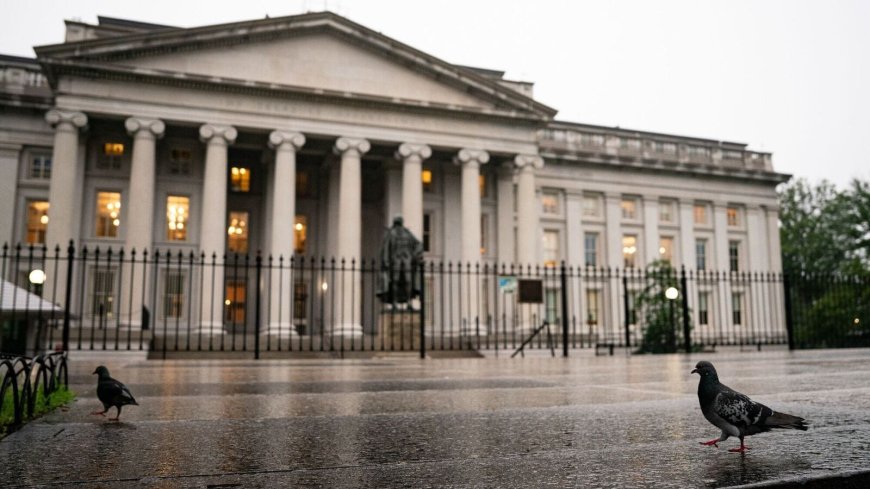The Bond Market’s Biggest Risk Isn’t the Deficit, Economist Says. Here’s What Is
While deficits worry many, economists warn the bond market’s real threat lies in high interest rates, liquidity shrinkage, and changing global demand.

Introduction: Rethinking Risk in the Bond Market
For years, the ballooning U.S. fiscal deficit has been flagged as the primary threat to the bond market. Yet, contrary to this popular narrative, some economists argue that the true vulnerability lies elsewhere — in the structural shifts within the global economy and central banks’ evolving policy stances. While deficits continue to raise concerns about long-term debt sustainability, a deeper and more immediate risk might be lurking in the form of persistently high interest rates, shrinking liquidity, and weakening demand for U.S. Treasuries.
The Conventional Narrative: Deficits as a Threat
The U.S. federal government’s debt has surpassed $34 trillion, and interest payments on that debt are rising rapidly. These figures have led many market participants to predict higher yields on long-term Treasuries as investors demand greater compensation for increased fiscal risk.
"Everyone's focused on the deficit," said Priya Misra, head of global rates strategy at TD Securities. “It’s definitely a concern over the long run, but markets don’t operate on a 10- or 20-year horizon.”
Indeed, despite record issuance of government debt, U.S. bond yields have remained relatively stable, suggesting investors are more influenced by near-term dynamics than by the size of the deficit alone.
The Real Threat: Structural Shifts in Rate Regimes
A growing number of economists now argue that the primary risk to bond markets isn't the size of the federal deficit, but the return of a higher interest rate environment — driven by persistent inflation, tighter monetary policy, and shifting investor behavior.
“Markets are not pricing in the possibility that the Fed’s ‘neutral rate’ may be higher than pre-pandemic levels,” said Jason Furman, former Chair of the Council of Economic Advisers. “If that’s the case, yields across the curve could remain elevated, which would pressure bond prices regardless of fiscal deficits.”
The Federal Reserve has signaled fewer rate cuts in 2025 than initially anticipated. Core inflation has proven sticky, and wage growth remains robust — all of which point toward a more hawkish stance for longer. The implication is clear: the bond market may have to adjust to a ‘higher-for-longer’ world.
Liquidity Constraints and Declining Foreign Demand
Another pressing risk factor is the erosion of liquidity in the Treasury market and declining foreign participation. China, once one of the largest holders of U.S. Treasuries, has steadily reduced its holdings amid geopolitical tensions and diversification strategies.
According to Treasury Department data, foreign ownership of U.S. government debt as a percentage of total outstanding has been falling. In 2014, foreigners held about 34% of the total U.S. debt. That figure is now closer to 24%.
“This shift puts more pressure on domestic buyers like banks and mutual funds,” said Nancy Davis, chief investment officer at Quadratic Capital. “If yields rise and buyers hesitate, we could see episodes of volatility similar to the UK gilt crisis in 2022.”
Moreover, the Federal Reserve is still engaged in quantitative tightening, draining liquidity from the financial system. Combined with reduced foreign appetite, this could spell trouble for Treasury auctions and overall bond stability.
Investor Behavior and the Repricing of Duration Risk
Bond investors are also re-evaluating duration risk in this volatile environment. With yields higher and inflation expectations more uncertain, long-dated bonds have become less attractive. The 10-year Treasury yield recently hovered around 4.3%, a sharp increase from the sub-1% levels seen during the pandemic.
“Duration has become more dangerous,” said Jim Bianco, founder of Bianco Research. “In a rising-rate world, investors have to be compensated more, and we’re not seeing the necessary risk premium being baked into long-term Treasuries.”
This has prompted institutional investors to stay shorter on the curve, preferring 2-year and 5-year notes over the traditional 10- and 30-year bonds. The result is a steeper yield curve, driven not by confidence in future growth but by aversion to long-term risk.
Market Context: Bonds Struggle Despite Risk-Off Sentiment
Typically seen as a safe haven, Treasuries haven’t performed well even during periods of equity market stress. This raises questions about the bond market’s ability to serve its traditional role in diversified portfolios.
Despite recession warnings and multiple global flashpoints — including conflicts in Eastern Europe and the Middle East — bond prices have not surged. The inverse relationship between risk sentiment and bond yields appears weaker than in previous cycles.
“Bonds are no longer the hedge they used to be,” said Mohamed El-Erian, chief economic adviser at Allianz. “That’s a fundamental shift that should be on every investor’s radar.”
Investor Outlook: Adapt or Be Left Behind
With so many crosswinds affecting the bond market, investors need to rethink strategies that worked in a low-rate world. Diversification into alternatives, active duration management, and inflation-protected securities are increasingly critical.
Key considerations for investors:
-
Shorten duration: Stay in shorter-term bonds to minimize interest rate risk.
-
Diversify globally: Consider sovereign debt in emerging markets or countries with better fiscal positioning.
-
Inflation hedges: Treasury Inflation-Protected Securities (TIPS) and commodities may offer better protection than nominal Treasuries.
-
Be wary of assumptions: Don’t assume bond yields will fall just because equity markets weaken.
In conclusion, while the deficit remains an important macroeconomic issue, the bond market’s immediate risks are more complex and dynamic. From shifting rate expectations to structural liquidity changes and evolving investor psychology, the landscape is unlike any seen in recent history.
What's Your Reaction?
 Like
0
Like
0
 Dislike
0
Dislike
0
 Love
0
Love
0
 Funny
0
Funny
0
 Angry
0
Angry
0
 Sad
0
Sad
0
 Wow
0
Wow
0













































































